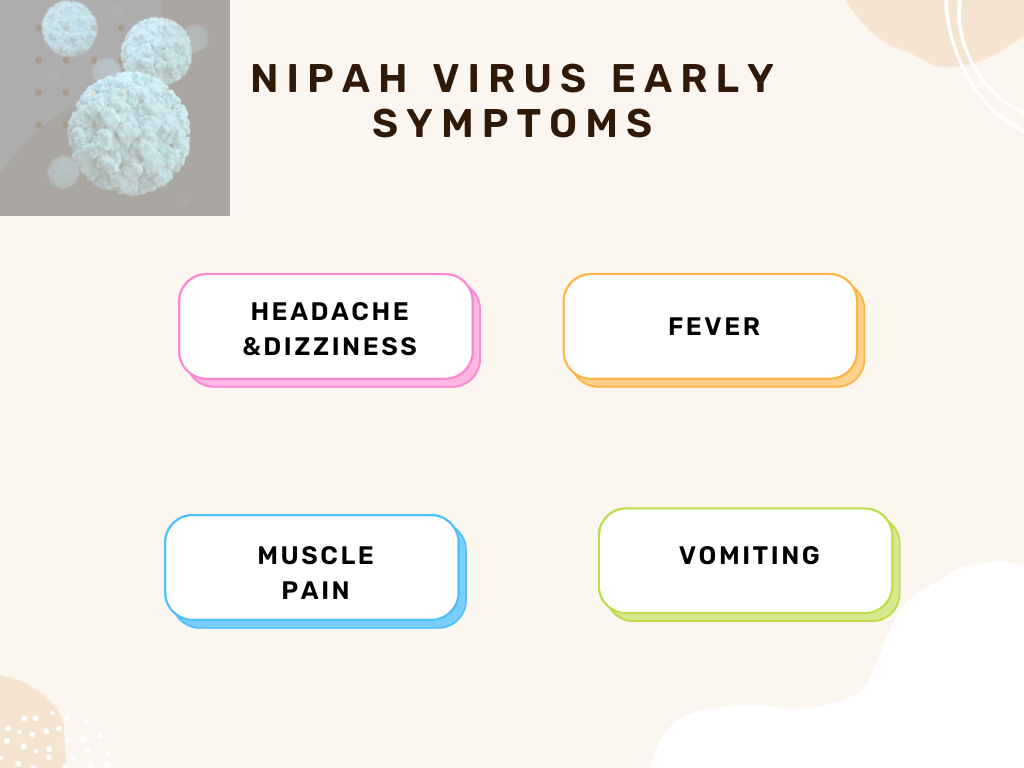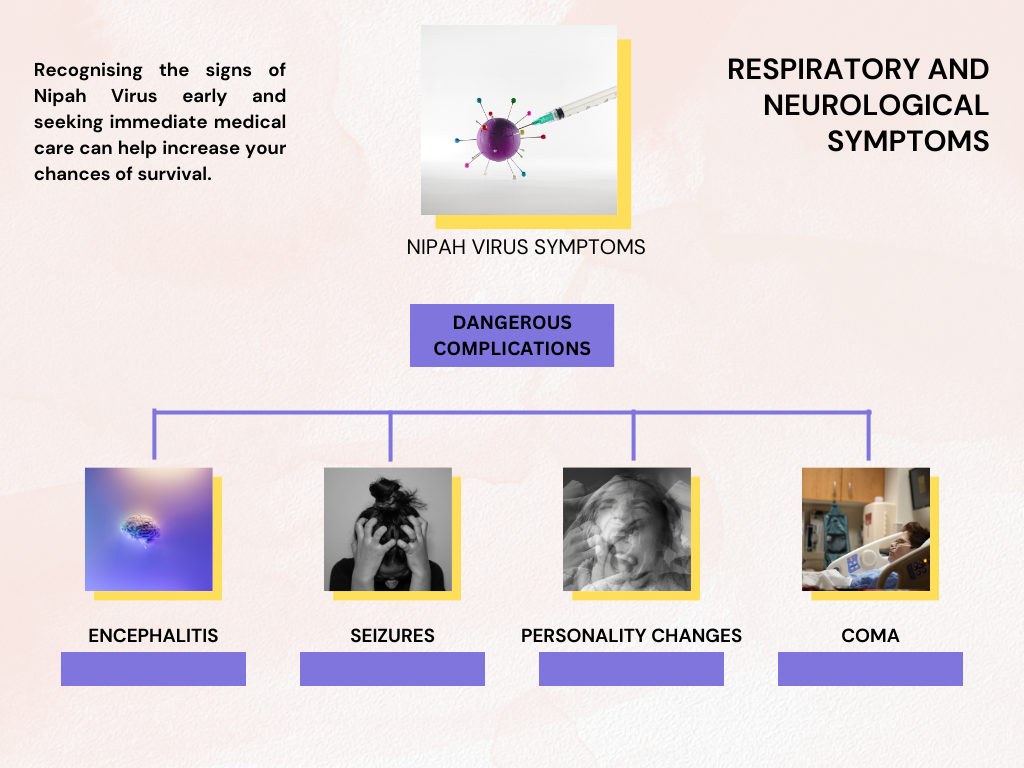Ever notice strange symptoms popping up around you abd worry it could be something serious? In this blogpost we will discus Nipah virus symptoms. we have all been there. In today’s world of emerging diseases, its normal to be concerned when you or someone you know shows signs of illness that seems out of ordinary. The key is staying informed so you know when its probably nothing to worry about or when its time to call the doctor.
Table of Contents
What is Nipah Virus?
Nipah is a zoonotic virus (transmitted from animals to humans) that can cause range of illnesses in people, from asymptomatic infection to acute respiratory illness and fatal encephalitis. The virus was first identified in 1999 during an outbreak of illness affecting pig farmers and others in close contact with pigs in Malaysia and Singapore.
Nipah Virus naturally infect fruit bats of the Pteropus genus, also known as flying foxes. These bats are found throughout Southeast Asia, Australia, Africa and islands in the Indian and Pacific Oceans. People can get infected with Nipah Virus from direct contact with infected bats, infected pigs or infected people. Some common ways for Nipah Virus to spread from bats or pigs to people include :
- Drinking raw date palm sap contaminated with infected bat droppings or saliva.
- Close contact with infected pigs or their bodily secretions.
- Close contact with infected people including providing unprotected caregiving.
Nipah Virus symptoms usually appear between 4 to 14 days after exposure. Early signs include:
- Fever, headache, dizziness, drowsiness
- Disorientation or confusion
- Vomiting
- Muscle pain
As the disease progresses , inflammation of brain (encephalitis ) can develop, leadind to severe and life-threatening symptoms including convulsions, delirium or coma. Unfortunately, there is currently no vaccine or specific treatment available for Nipah Virus infection. The primary treatment is supportive care.
With prompt diagnosis and supportive care, the fatality rate can be reduced. So if you have been in an area where Nipah Virus is found and experience these symptoms, see your doctor right away. Early diagnosis and treatment can save lives.
Early Nipah Virus Symptoms to look out for:
If you start experiencing these symptoms, Nipah Virus infection could be the culprit. Monitor yourself closely and see a doctor right away.
- Headache and dizziness. Early on, you may notice a severe, pounding headache and feeling of light headedness and vertigo.
- Fever. A high fever, often over 101 F, is common and can last for several days.
- Muscle pain. You may experience muscle aches, pain and weakness all over your body.
- Vomiting. Repeated vomiting and nausea are frequently reported and lead to dehydration if severe.

After the initial nipah virus symptoms, the virus progresses rapidly. Be on alert for these additional signs in the coming days:
- Altered mental state: Watch for confusion, drowsiness, disorientation and even seizures in coma. The virus can inflame the brain.
- Respiratory problems. Difficulty breathing, wheezing and chest pain may indicate the infection has spreaded to the lungs. This is medical emergency.
- Abdominal Pain. Sharp pain in the belly, especially below the ribs, can be a sign the virus is affecting the spleen or lymph nodes.
Nipah Virus has no specific treatment , so care is supportive. But with early diagnosis and monitoring , fatality rates can be reduced. See your doctor immediately if you notice these symptoms – the quicker you get medical help, the better your chances of surviving the dangerous disease.
With awareness and the right precautions, we can slow the spread of Nipah Virus and save lives. Look out for the signs, and stay safe.
How Nipah Virus symptoms progress over time
Once infected with Nipah Virus symptoms typically appear between 4 10 14 days after exposure. As the illness progresses, symptoms can worsen rapidly. Initially, you may experience:
- Fever
- Headache
- Muscle pain
- Vomiting
- Sore throat
Respiratory and Neurological Symptoms
After a few days, the virus can start attacking your respiratory system and central system. You develop a cough, have difficulty breathing and experience neurological issues like dizziness or confusion . Some may slip into coma as the disease advances.
Dangerous Complications
Without treatment, Nipah virus infection can lead to dangerous complications such as:
- Encephalitis (inflammation of the brain)
- Seizures
- Personality changes
- Coma
Last-Stage Symptoms
In the final stages of Nipah Virus symptoms become severely severe. Patients often experience acute respiratory distress with breathing difficulties , convulsions and sometimes excessive bleeding. Tragically many people do not survive one symptoms progress to this point.
The time period from initial symptoms to death is usually between 9 to 16 days. However, some patientshave survived after months of hospitalisation and intensive care. With supportive care , the fatality care can be reduced to 40-75%.
Recognising the signs of Nipah Virus early and seeking immediate medical care can help increase your chances of survival. Doctors may administer Ribavirin, an antiviral medication, to help support your recovery, along with other treatments aimed at managing symptoms. The key is quick action and close monitoring as this disease can rapidly become life-threatening without prompt diagnosis and care.

Diagnosing Nipah based on Symptoms
Once infected with the nipah virus symptoms may appear within 4 to 14 days. The initial symptoms are fairly non-specific, but as the disease progresses, you may experience the following telltale signs:
- Fever and headache: Early on, you may notice a high fever, usually over 101 F or 38.5 C along with a severe headache. These are some of the first indicators that you may have been exposed to Nipah Virus.
- Cough and sore throat: A dry cough and sore throat frequently develop, caused inflammation of the respiratory tract. The cough is initially dry but can progress to produce mucus or blood.
- Muscle Pain: Generalised muscle pain, especially in the back and limbs is common and can range from mild to severe. This is due to inflammation of the muscles and tissues.
- Vomiting and nausea: Nausea, vomiting and abdominal pain tend to appear early in the course of the illness. These gastrointestinal symptoms are a result of the virus infecting the lining of the stomach and intestines.
- Dizziness or altered consciousness : Some patients experience dizziness ,drowsiness or even lapse into a coma. These neurological symptoms indicate the virus has spread to the brain,a dangerous complication known as Nipah encephalitis.
- Difficulty breathing: Around 50% of people develop severe respiratory problems like pneumonia or acute respiratory distress syndrome. This can lead to difficulty breathing, chest pain and a bluish tint to the lips or face due to lack of oxygen.
If you experience these symptoms, especially within two weeks of potential exposure, see you doctor as a first priority for accurate diagnosis and treatment. Timely care and supportive treatment in an intensive care unit can help reduce the risk of severe illness and death. Rapid diagnosis is key to containing outbreaks, so report any potential contact with infected individuals or animals to public health authorities immediately.
When to seek Medical Care for Nipah Virus symptoms
As the Nipah Virus progresses, the symptoms become increasingly severe. At this point, its critical to seek immediate medical care. Call emergency services or go to your nearest hospital right away if you or loved one experience the following dangerous symptoms.
Difficulty breathing
The Nipah Virus can inflame the brain and spinal cord, causing the muscles that control breathing to stop working properly. If breathing becomes laboured or shallow or if the person turns blue call for emergency help immediately.
Dizziness or confusion
Feeling lightheaded, unsteady or confused can indicate the virus is infecting the brain. The person may feel off balance, have trouble walking or experience disorientation. These signs mean that virus is progressed and medical care is needed.

Seizures
Seizures occur when the virus causes abnormal electrical activity in the brain. Seizures requires emergency care as they can quickly become life-threatening if not properly treated. Call for emergency help right away if someone has a seizure.

High fever
While a fever is an early symptom of Nipah Virus , an extremely high fever, especially over 104 F or 40 c, can lead to seizures or other complications if left untreated. Seek medical care immediately for a high fever, especially in children, elderly or immunocompromised people.
Muscle weakness
Feeling very weak or having trouble moving parts of the body could indicate the virus is damaging the spinal cord or muscles. Seek immediate medical care if muscle weakness develops, as it can progress rapidly and become life-threatening if not treated promptly.
Nipah Virus symptoms become dangerous quickly, so seek medical care right away if you notice these severe signs in yourself or someone else. Early treatment and supportive care are critical for recovery and preventing life-threatening complications. Call emergency services or go to your nearest hospital immediately.
FAQs: Nipah Virus Symptoms
1. What are the common symptoms of Nipah Virus Infection?
- Common symptoms of Nipah virus infection include fever, headache, muscle pain, fatigue, and sore throat. These symptoms can resemble those of other viral illnesses and may initially be mild.
2. Are respiratory symptoms a common feature of Nipah Virus Infection?
- Yes, respiratory symptoms such as cough, shortness of breath, chest pain, and difficulty breathing can occur in individuals with Nipah virus infection. These symptoms may indicate involvement of the respiratory system.
3. How do neurological symptoms manifest in Nipah Virus Infection?
- Neurological symptoms of Nipah virus infection may include confusion, disorientation, seizures, focal neurological deficits, and coma. These signs indicate involvement of the central nervous system and may be life-threatening.
4. Can Nipah Virus Infection cause encephalitis?
- Yes, Nipah virus infection can lead to encephalitis, which is inflammation of the brain. Encephalitis may present with symptoms such as fever, headache, altered mental status, and neurological dysfunction.
5. What are the early warning signs of severe Nipah Virus Infection?
- Early warning signs of severe Nipah virus infection may include respiratory distress, vomiting, altered mental status, and neurological symptoms such as seizures or coma. These signs indicate a more severe form of the illness and require urgent medical attention.
6. Are there specific symptoms that differentiate Nipah Virus Infection from other viral illnesses?
- While many symptoms of Nipah virus infection overlap with those of other viral illnesses, the presence of neurological symptoms such as confusion, seizures, or coma may suggest Nipah virus involvement. Additionally, respiratory symptoms combined with neurological manifestations can raise suspicion for Nipah virus infection.
7. How long do Nipah Virus Symptoms typically last?
- The duration of Nipah virus symptoms can vary depending on individual factors and the severity of the infection. Mild cases may resolve within a few days to weeks, while severe cases with neurological complications may have a longer course and require intensive medical care.
8. Can Nipah Virus Infection be asymptomatic?
- Yes, some individuals infected with Nipah virus may remain asymptomatic or experience only mild symptoms that go unnoticed. However, asymptomatic individuals can still transmit the virus to others, highlighting the importance of vigilance and infection control measures.
9. When should I seek medical attention for Nipah Virus Symptoms?
- If you experience symptoms consistent with Nipah virus infection, such as fever, headache, respiratory distress, or neurological symptoms, seek medical attention immediately. Early diagnosis and supportive care are essential for managing Nipah virus infection effectively.
10. Are there any long-term effects of Nipah Virus Infection?
- In severe cases, Nipah virus infection can lead to long-term neurological sequelae, including cognitive impairment, motor deficits, and persistent neurological symptoms. However, the extent of long-term effects may vary depending on the severity of the initial infection and the timeliness of medical intervention.
Conclusion
So there you have it, a comprehensive overview of the symptoms and signs to watch out for with Nipah Virus infection. Early detection is critical, so if you experience any combination of fever, headache, dizziness or nausea, especially if you have recently travelled or been in contact with bats, pigs or other infected animals, see your doctor right away. The earlier treatment begins, the better your chances of survival and avoiding long-term side effects. Stay vigilant, take recommended precautions, and warn others in areas where niaph virus is active or emerging. Knowledge is power in the fight against the deadly disease.





Pingback: The Deadly Nipah Virus: A Lethal Zoonotic Disease - HEALTHILY EVER AFTER